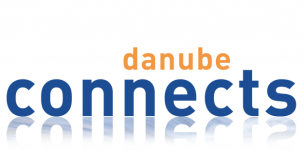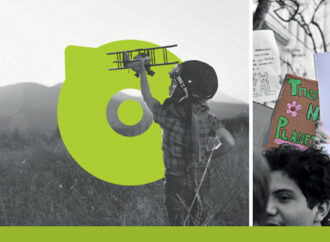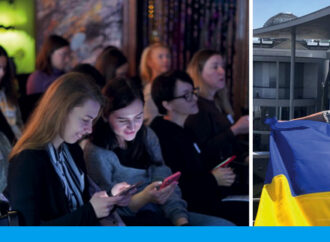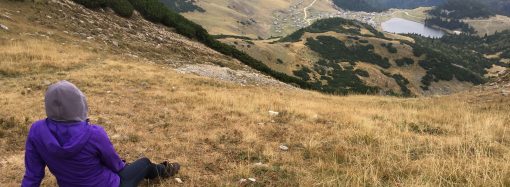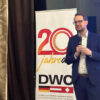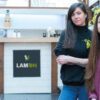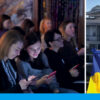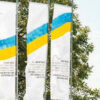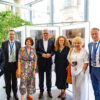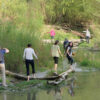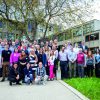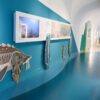The Danube Offi ce Ulm/Neu-Ulm has long been an important partner and source of information for danube connects – after all, it has been acting as a project agency for interregional cooperation since 2002 and supports encounters and exchanges in the whole Danube region. Our readers have certainly already come across the biennial Danube Festival
The Danube Offi ce Ulm/Neu-Ulm has long been an important partner and source of information for danube connects – after all, it has been acting as a project agency for interregional cooperation since 2002 and supports encounters and exchanges in the whole Danube region.
Our readers have certainly already come across the biennial Danube Festival in the magazine. During those ten days both sides of the river teem with people and events, international artists and guests from all countries along the Danube meet in Ulm and Neu-Ulm. The main organizer and promoter of the cultural celebration and similar events
like the Danube Salon is the Donaubüro Ulm/Neu-Ulm. And these are just two of the many activities of the office – it is not without reason that it sees itself as the driving force, or – with a view to the Danube, more appropriately – as the “hydroelectric power plant” of in-
terregional projects. These promote encounters and exchanges in the Danube region in the fields of education, administration and ecology, for example at the Danube Youth Camp in Ulm/Neu-Ulm or at working meetings for knowledge transfer between local politicians
in the Danube countries.
One of the office’s main areas of focus is sustainable mobility in tourism, which it is also involved in locally in Ulm/Neu-Ulm, particularly in the project “Sustainable Mobility for Ulm/Neu-Ulm”, funded by the German Programme for Transnational Cooperation. The project represents an important step towards achieving low-carbon traffic and makes
a valuable contribution to climate proection. Its three work packages aim at implementing the tourism and mobility plan for the Ulm/Neu-Ulm region, preparing a physical mobility center in Ulm and consolidating the cross-sectoral and cross-institutional cooperation
of the regional tourism and mobility actors. In addition to regional events such as network meetings or the “mobility training for tourism professionals”, two online workshops were also organised in June in cooperation with the municipal working group on tourism
and mobility. Both aimed at the successful communication of sustainable transport. The first one with Wolfgang Aichinger, project manager for urban mobility at the “Agora Verkehrswende” initiative, focused on the need for fundamentally rethinking the choice of
transport modes and a corresponding communication strategy. The second workshop with Jaime Valdés Valverde, mobility planner at the gardening and civil engineering companies of the city of Lindau, presented concrete best practices of measures and strategies which
are partly responsible for Lindau’s success in the field of sustainable mobility in recent years.
Exploring the most beautiful “pearls” sustainably
The Danube.Pearls working group unites tourism stakeholders and organisations representing 11 destinations from 8 countries along the Danube in a single network. The network is a result of the EU project Transdanube.Pearls, which ran from 2017 to 2019 and counteracted the negative effects of automobile traffic by developing socially fair, economically feasible, environmentally friendly and health-promoting mobility services for visitors to the Danube region. The Danube.Pearls initiative builds on the project’s results in its aims to jointly use the boundless potential of the river and to off er people the opportunity to explore the Danube region gently and without their own car.
The term “gentle” refers to sustainable means of transport that open up environmentally friendly perspectives for discovery tours along the river, for example by train, by bicycle along the Danube cycle path or by canoe, kayak etc. The “pearls” include Ulm/Neu-Ulm, Lake Neusiedl, the Bratislava region, Szigetköz Island and Mohács in Hungary, Vukovar in Croatia and the Iron Gate and Danube Delta in Romania. Danube.Pearls collects the most
important sights for each destination on its website and provides tips and information on “soft” mobility on site. In Ulm, workshops for regional exchange between the actors involved were also organised for this purpose and a list of measures was drawn up which have since been implemented step by step. Training courses such as the one for tourism experts are also intended to raise awareness for the topic.
New narratives for the Danube region
The Danube Office is also involved in a sustainability project linked to the “Pearls” theme, the “Transdanube Travel Stories”. The transnational project, supported by the EU funding programme Danube Transnational, with 10 partners from 7 countries, started on 1 July and
is managed by the Austrian Umweltbundesamt GmbH. “The Danube Region is a wonderful region with a heritage worthy of cultural protection. The project aims to develop new narratives in order to position it more strongly in terms of tourism. With these narratives,
we want to link places of interest thematically and advertise them”, explains Veronika Wierer, Head of the Danube Office’s Project Agency. The Office brings its expertise in the field of sustainable mobility in tourism to the project. Among other things, Wierer’s team will develop a practical transnational mobility training for tourism experts and an e-learning course. Representatives of each participating network – e.g. DANUBE PARKS, St. Martin’s Way and the Road of Emperors and Kings – are to be trained and will carry the knowledge into their network.
“With the communication of sustainable means of transport, we want to enable people from the region to experience the Danube region in the spirit of international understanding – and preferably in the most environmentally friendly way possible. In this way the whole thing should also benefit the local people, because they too should learn how to travel there sustainably,” says Wierer.
Daniel Hirsch,
journalist, Budapest
